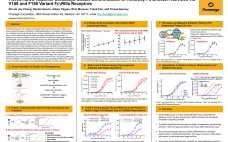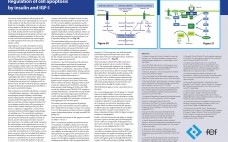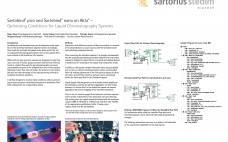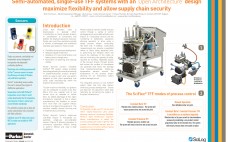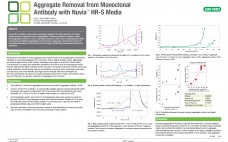Antibody-dependent cell-mediated cytotoxicity (ADCC) contributes to clinical efficacy of a broad range of therapeutic antibodies. FcγRIIIa polymorphism of individual cancer patients are correlated with clinical efficacy of some of these antibody drugs. Classic ADCC cytotoxicity assays rely on primary effector cells, which are highly heterogeneous and variable. To quantitatively measure antibody activity and evaluate the impact of FcγRIIIa polymorphism, we developed a pair of reporter-based ADCC assays using two engineered effector cell lines in Jurkat that stably express an NFAT-RE driven…
2014 Collection
Regulation of cell apoptosis by insulin and IGF-I
An increase in the number of cells growing in cell culture is the result of two opposing effects: an increase in the number of cells that traverse the cell cycle and divide into two daughter cells (mitosis), or a decrease in the number of cells that die according to different modalities, the most prominent one being apoptosis (1), or both. Insulin and IGF-I are both capable of facilitating cell progression through the cell cycle, and of inhibiting apoptotic mechanisms. In…
Next Generation Depth Filters for the Clarification of Flocculated Mammalian Cell Culture
Increasingly high cell density, high product titer cell cultures, containing mammalian cells are placing a larger burden on traditional downstream clarification and purification operations due to higher product and impurity levels. EMD Millipore has addressed these challenges by developing a proprietary single-use technology to improve primary and secondary direct depth filtration of flocculated high cell density mammalian cell cultures. The use of graded depth filters, combined with pre-treatment technologies, have achieved higher primary throughput capacities and lower flushing volumes as…
Platform Purification of a Domain Antibody
Monoclonal antibodies (MAbs) are very successful for treatment of several different cancers and tumors. However, the low tissue penetration has led to the development of smaller sized biopharmaceuticals (Ab fragments) such as Fabs, single chain Fv (scFv) and domain antibodies (Dabs). These molecules lack the Fc part of the antibody making a platform purification approach using Protein A impossible. However, with the introduction of the Protein L based affinity chromatography media (Captoâ„¢ L) new possibilities are introduced for capture of…
Sartobind® pico and Sartobind® nano on Akta® – Optimizing Conditions for Liquid Chromatography Systems
Sartobind pico and Sartobind nano are the laboratory-scale mem-bers of the Sartobind membrane adsorber family. Accordingly, their small size and high throughput make them perfect for use on automated chromatography systems such as the popular Akta series offered by GE Healthcare Life Sciences.While both the pico and nano capsules are designed for high flow rates, the array of valves, pumps, monitors and the flow restrictor found in a typical flow path for gel chromatography can cause unacceptable pressures at the…
Semi-automated, Single-use TFF Systems With an ‘Open Architecture’ Design Maximize Flexibility and Allow Supply Chain Security
Cross flow filtration used in bioprocesses is typically either microfiltration to clarify process streams or ultrafiltration to concentrate and diafilter the biopharmaceutical molecule. Single-use cross flow operations provide a number of advantages over traditional stainless steel systems. These include: • Flexibility during process development • Reduced capital investment • Avoidance of cross contamination and faster product change overs • Elimination of steaming and cleaning utilities Parker domnick hunter’s innovative SciFlex® TFF system utilizes propriety technology allowing the sterile processing of…
Liquid-Liquid Porometry of Viresolve® Pro Membrane
A liquid-liquid porometry (LLP) test was developed to characterize the pore size distribution of Viresolve® Pro membrane. Data generated by this test supports the understanding of the size-based virus removal mechanism of the filter. The LLP test also is used at-line during membrane casting. Process control based on LLP results improves membrane consistency.
Progress On A Fully Disposable Downstream Platform: A Simple, Risk-Free, Plug-in Solution To Solve The DSP Bottleneck
Natrix HD Membrane technology features a polymeric hydrogel formed within a flexible porous support matrix. The support matrix provides mechanical strength, while the hydrogel properties determine the separation chemistry of the product. An advantage of the Natrix chemistry is the ability to place virtually any functional group chemistry throughout the hydrogel polymer. Natrix HD membrane technology combines the superior binding capacity of conventional resinbased columns with the high throughput of membranes in a single-use format that eliminates costly packing, cleaning,…
A Case Study: 3-step Process for Efficient mAb Purification
This study showcases a portfolio of commercially available biopharmaceutical chromatography resins designed for the efficient purification of monoclonal antibodies. A 3-step purification process has been implemented which showed effective removal of the main contaminants, low ligand leakage, and high yields over the entire process. Eshmuno® A affinity chromatography resin was evaluated as the first step in the process. The Protein A elution pool was further purified using cation exchange chromatography. Two cation exchange resins with different selectivities were compared. The…
Aggregate Removal from Monoclonal Antibody with Nuvia™ HR-S Media
Nuvia HR-S media is a new cation exchanger designed for high resolution of closely related product impurities such as aggregates. It delivers excellent resolution, with a final aggregate content of <0.3%, and high recovery of >80% from a heterogeneous feed of monoclonal antibody aggregates and monomer. Aggregate content and recovery in the eluate were shown to be functions of the target conductivity measured at the end of collection.

